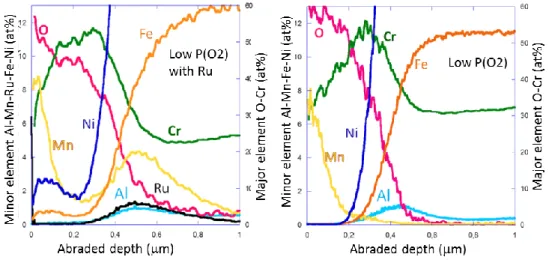HAL Id: cea-02499858
https://hal-cea.archives-ouvertes.fr/cea-02499858
Submitted on 5 Mar 2020HAL is a multi-disciplinary open access
archive for the deposit and dissemination of sci-entific research documents, whether they are pub-lished or not. The documents may come from teaching and research institutions in France or abroad, or from public or private research centers.
L’archive ouverte pluridisciplinaire HAL, est destinée au dépôt et à la diffusion de documents scientifiques de niveau recherche, publiés ou non, émanant des établissements d’enseignement et de recherche français ou étrangers, des laboratoires publics ou privés.
On the role of oxygen partial pressure on the
composition of the oxide layer formed on alloy 690 at
700°C
Magali Moeglen, Stéphane Perrin, Loïc Marchetti, Michel Tabarant, Marc
Foucault, Yves Wouters
To cite this version:
Magali Moeglen, Stéphane Perrin, Loïc Marchetti, Michel Tabarant, Marc Foucault, et al.. On the role of oxygen partial pressure on the composition of the oxide layer formed on alloy 690 at 700°C. HTCPM 2016 - 9th International Symposium on High-Temperature Corrosion and Protection of Materials, May 2016, Les Embiez, France. �cea-02499858�
ON THE ROLE OF OXYGEN PARTIAL PRESSURE ON THE
COMPOSITION OF THE OXIDE LAYER FORMED ON ALLOY 690 AT
700°C
Magali MOËGLEN
1,4, Stéphane PERRIN
1, Loïc MARCHETTI
1, Michel TABARANT
2, Marc
FOUCAULT
3, Yves WOUTERS
41
CEA, DEN, DPC, SCCME, Laboratoire d’Étude de la Corrosion Aqueuse, F-91191 Gif-sur-Yvette, France
2
CEA, DEN, DPC, SEARS, Laboratoire d’Ingénierie des Surfaces et Lasers, F-91191 Gif-sur-Yvette, France
3
Areva ANP, Ctr Tech, Dept Corros Chim, F-71205 Le Creusot, France.
4
Université de Grenoble, SIMaP, F-38402, Saint Martin d’Hères, France
Keywords : Alloy 690, oxidation, oxygen partial pressure, O2 dissociation catalysis.
Extended Abstract : Steam generator tubes in pressurized water reactors (PWR) are made of nickel
based alloy such as alloy 600 or alloy 690. During oxidation process of this alloy in water at high temperature, nickel cations are released in the primary media. After neutron flux exposure in the reactor core, these cations can turn into radioactive products, such as 58Co. If carried through the primary circuit, these radioactive products precipitate and contaminate the loop, making maintenance more difficult.
In order to limit nickel cation release, the aim of this work is to form a very protective scale (continuous, rich in chromium and nickel free) at the Alloy 690 surface by a pre-oxidation treatment performed at 700°C under different oxygen partial pressures (low P(O2)≈10-6 bar and high P(O2)≈0.2
bar). So oxidation kinetic study of alloy 690 has been performed by thermogravimetry which has shown no effect of P(O2) on the variations of oxidation rate over time. The morphology of the oxide
scale formed during the test was observed using Scanning Electron Microscopy (SEM) and Transmission Electron Microscopy (TEM). The results are very similar for both P(O2) : the scale is
made of a continuous layer and preferential oxidation along the alloy grain boundaries (GB). Just beneath the oxidized zone in alloy GB, the formation of cavities is also observed. Moreover glow discharge optical emission spectrometry (GDOES) and X-ray Diffraction analyses have highlighted in
both cases an oxide layer rich in chromium (Cr2O3). Nevertheless for low P(O2), a Mn and Cr spinel is
observed near the outer surface of the scale whereas for higher P(O2), a similar spinel layer is made ?
of Ni, Fe, Mn and Cr. So the oxygen partial pressure modifies the oxide composition although it has no effect on the oxidation kinetics. In order to better understand the influence of P(O2) on oxide
composition and on its evolution over time, two kind of experiments have been performed. The first one used a catalyst or an inhibitor in order to increase or decrease the dissociation rate of oxygen. Thus, ruthenium has been deposited on the alloy surface before oxidation in low P(O2) in order to
enhance the O2 dissociation rate. As show in figure 1, the better dissociation of oxygen at the surface
entails the formation of an oxide layer containing nickel and iron at the external interface which was not the case for a sample without ruthenium. On the contrary, gold has been used as a O2
dissociation inhibitor for experiment with high P(O2). The gold deposit also modify the composition of
the oxide layer. When gold is deposited prior to oxidation test, the oxide layer formed under high P(O2) is free of nickel and iron contrary to what is observed without gold. These experiments show
that oxygen dissociation rate play a role on the oxide composition formed on nickel base alloys at 700°C.
Figure 1. GD-OES profiles performed on oxide scale formed on Alloy 690, with and without deposit of
ruthenium prior to oxidation test, after about 300h of oxidation at 700°C under low P(O2).
The second kind of experiment corresponds to oxidation tests with change of P(O2) at the start of
isothermal stage at 700°C. These experiments with a change of atmosphere have underlined the importance of the P(O2) during the transient heating stage on the final composition of the oxide
layer.
These experiments enable to better understand the link between the dissociation of oxygen at the external interface and the composition of the oxide layer formed on alloy 690 at 700°C.
